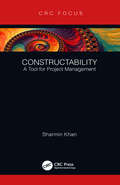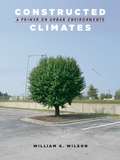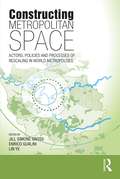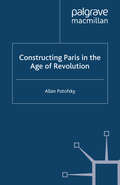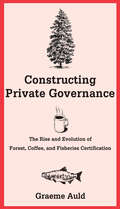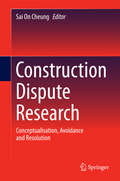- Table View
- List View
Constitutive Modeling of Geomaterials: Advances and New Applications (Springer Series in Geomechanics and Geoengineering)
by Qiang Yang Jian-Min Zhang Hong Zheng Yangping YaoThe Second International Symposium on Constitutive Modeling of Geomaterials: Advances and New Applications (IS-Model 2012), is to be held in Beijing, China, during October 15-16, 2012. The symposium is organized by Tsinghua University, the International Association for Computer Methods and Advances in Geomechanics (IACMAG), the Committee of Numerical and Physical Modeling of Rock Mass, Chinese Society for Rock Mechanics and Engineering, and the Committee of Constitutive Relations and Strength Theory, China Institution of Soil Mechanics and Geotechnical Engineering, China Civil Engineering Society. This Symposium follows the first successful International Workshop on Constitutive Modeling held in Hong Kong, which was organized by Prof. JH Yin in 2007. Constitutive modeling of geomaterials has been an active research area for a long period of time. Different approaches have been used in the development of various constitutive models. A number of models have been implemented in the numerical analyses of geotechnical structures. The objective of the symposium is to provide a forum for researchers and engineers working or interested in the area of constitutive modeling to meet together and share new ideas, achievements and experiences through presentations and discussions. Emphasis is placed on recent advances of constitutive modeling and its applications in both theoretic and experimental aspects. Six famous scholars have been invited for the plenary speeches of the symposiums. Some prominent scholars have been invited to organize four specialized workshops on hot topics, including “Time-dependent stress-strain behavior of geomaterials”, “Constitutive modeling within critical state soil mechanics”, “Multiscale and multiphysics in geomaterials”, and “Damage to failure in rock structures”. A total of 49 papers are included in the above topics. In addition, 51 papers are grouped under three topics covering “Behaviour of geomaterials”, “Constitutive model”, and “Applications”. The editors expect that the book can be helpful as a reference to all those in the field of constitutive modeling of geomaterials.
Constitutive Modelling in Geomechanics: Introduction
by Alexander PuzrinThe purpose of this book is to bridge the gap between the traditional Geomechanics and Numerical Geotechnical Modelling with applications in science and practice. Geomechanics is rarely taught within the rigorous context of Continuum Mechanics and Thermodynamics, while when it comes to Numerical Modelling, commercially available finite elements or finite differences software utilize constitutive relationships within the rigorous framework. As a result, young scientists and engineers have to learn the challenging subject of constitutive modelling from a program manual and often end up with using unrealistic models which violate the Laws of Thermodynamics. The book is introductory, by no means does it claim any completeness and state of the art in such a dynamically developing field as numerical and constitutive modelling of soils. The author gives basic understanding of conventional continuum mechanics approaches to constitutive modelling, which can serve as a foundation for exploring more advanced theories. A considerable effort has been invested here into the clarity and brevity of the presentation. A special feature of this book is in exploring thermomechanical consistency of all presented constitutive models in a simple and systematic manner.
Constitutive Modelling of Granular Materials
by Dimitrios KolymbasIn view of its extreme complexity the mathematical description of the mechanical behaviour of granular materials is an extremely difficult task. Today many different models compete with each other. However, the complexity of the models hinders their comparison, and the potential users are confused and, often, disencouraged. This book is expected to serve as a milestone in the present situation, to evaluate the present methodes, to clear up the situation, to focus and encourage for further research activities.
Constraint Databases and Applications: First International Symposium, CDB 2004, Paris, France, June 12-13, 2004, Proceedings (Lecture Notes in Computer Science #3074)
by Bart Kuijpers Peter ReveszThe ?rst International Symposium on the Applications of Constraint Databases (CDB2004) took place in Paris, France, on June 12–13, 2004, just before the ACM SIGMOD and PODS conferences. Since the publication of the paper “Constraint Query Languages” by Kan- lakis, Kuper and Revesz in 1990, the last decade has seen a growing interest in constraint database theory, query evaluation, and applications, re?ected in a variety of conferences, journals, and books. Constraint databases have proven to be extremely ?exible and adoptable in environments that relational database systems cannot serve well, such as geographic information systems and bioinf- matics. This symposium brought together people from several diverse areas all c- tributing to the practice and the application of constraint databases. It was a continuation and extension of previous workshops held in Friedrichshafen, G- many (1995), Cambridge, USA (1996), Delphi, Greece (1997), and Seattle, USA (1998) as well as of the work in the comprehensive volume “Constraint Data- ses” edited by G. Kuper, L. Libkin and J. Paredaens (2000) and the textbook “Introduction to Constraint Databases” by P. Revesz (2002). The aim of the symposium was to open new and future directions in c- straint database research; to address constraints over domains other than the reals; to contribute to a better implementation of constraint database systems, in particular of query evaluation; to address e?cient quanti?er elimination; and to describe applications of constraint databases.
Constructability: A Tool for Project Management
by Sharmin KhanThis book focuses on Constructability, a project management tool and its effectiveness in promotion of sustainable development and architecture. Constructability concentrates on the optimum use of construction knowledge and experience in planning, engineering, procurement and field operations to achieve overall project objectives. Keeping in view the requirement of promotion of sustainable architectural practices, the book is aimed at establishing effective relationship between constructability and sustainability, including application of the project management systems and guidelines for sustainable development, in a systematic manner. Key Features Focuses on relationship between constructability and sustainability in detail, with respect to their definitions and historical background. Summarizes formulation of recommendations and guidelines for various design and construction practices Provides an updated information database having overview of constructability studies and researches conducted so far Explores association of sustainable development to project management issues Includes relevant case studies
Constructability: A Tool for Project Management
by Sharmin KhanThis book focuses on Constructability, a project management tool and its effectiveness in promotion of sustainable development and architecture. Constructability concentrates on the optimum use of construction knowledge and experience in planning, engineering, procurement and field operations to achieve overall project objectives. Keeping in view the requirement of promotion of sustainable architectural practices, the book is aimed at establishing effective relationship between constructability and sustainability, including application of the project management systems and guidelines for sustainable development, in a systematic manner. Key Features Focuses on relationship between constructability and sustainability in detail, with respect to their definitions and historical background. Summarizes formulation of recommendations and guidelines for various design and construction practices Provides an updated information database having overview of constructability studies and researches conducted so far Explores association of sustainable development to project management issues Includes relevant case studies
Constructal Law and the Unifying Principle of Design (Understanding Complex Systems)
by Luiz A.O. Rocha, Sylvie Lorente and Adrian BejanDesign happens everywhere, whether in animate objects (e.g., dendritic lung structures, bacterial colonies, and corals), inanimate patterns (river basins, beach slope, and dendritic crystals), social dynamics (pedestrian traffic flows), or engineered systems (heat dissipation in electronic circuitry). This “design in nature” often takes on remarkably similar patterns, which can be explained under one unifying Constructal Law. This book explores the unifying power of the Constructal Law and its applications in all domains of design generation and evolution, ranging from biology and geophysics to globalization, energy, sustainability, and security. The Constructal Law accounts for the universal tendency of flow systems to morph into evolving configurations that provide greater and easier access over time. The Constructal Law resolves the many and contradictory ad hoc statements of “optimality”, end design, and destiny in nature, such as minimum and maximum entropy production and minimum and maximum flow resistance, and also explains the designs that are observed and copied in biomimetics.Constructal Law and the Unifying Principle of Design covers the fundamentals of Constructal Theory and Design, as well as presenting a variety of state-of-the-art applications. Experts from the biological, physical and social sciences demonstrate the unification of all design phenomena in nature, and apply this knowledge to novel designs in modern engineering, such as vascularization for self-healing and self-cooling materials for aircraft, and tree fins and cavities for heat transfer enhancement.
Constructed Climates: A Primer on Urban Environments
by William G. WilsonAs our world becomes increasingly urbanized, an understanding of the context, mechanisms, and consequences of city and suburban environments becomes more critical. Without a sense of what open spaces such as parks and gardens contribute, it’s difficult to argue for their creation and maintenance: in the face of schools needing resources, roads and sewers needing maintenance, and people suffering at the hands of others, why should cities and counties spend scarce dollars planting trees and preserving parks? In Constructed Climates, ecologist William G. Wilson demonstrates the value of urban green. Focusing specifically on the role of vegetation and trees, Wilson shows the costs and benefits reaped from urban open spaces, from cooler temperatures to better quality ground water—and why it all matters. While Constructed Climates is a work of science, it does not ignore the social component. Wilson looks at low-income areas that have poor vegetation, and shows how enhancing these areas through the planting of community gardens and trees can alleviate social ills. This book will be essential reading for environmentalists and anyone making decisions for the nature and well-being of our cities and citizens.
Constructed Climates: A Primer on Urban Environments
by William G. WilsonAs our world becomes increasingly urbanized, an understanding of the context, mechanisms, and consequences of city and suburban environments becomes more critical. Without a sense of what open spaces such as parks and gardens contribute, it’s difficult to argue for their creation and maintenance: in the face of schools needing resources, roads and sewers needing maintenance, and people suffering at the hands of others, why should cities and counties spend scarce dollars planting trees and preserving parks? In Constructed Climates, ecologist William G. Wilson demonstrates the value of urban green. Focusing specifically on the role of vegetation and trees, Wilson shows the costs and benefits reaped from urban open spaces, from cooler temperatures to better quality ground water—and why it all matters. While Constructed Climates is a work of science, it does not ignore the social component. Wilson looks at low-income areas that have poor vegetation, and shows how enhancing these areas through the planting of community gardens and trees can alleviate social ills. This book will be essential reading for environmentalists and anyone making decisions for the nature and well-being of our cities and citizens.
Constructed Climates: A Primer on Urban Environments
by William G. WilsonAs our world becomes increasingly urbanized, an understanding of the context, mechanisms, and consequences of city and suburban environments becomes more critical. Without a sense of what open spaces such as parks and gardens contribute, it’s difficult to argue for their creation and maintenance: in the face of schools needing resources, roads and sewers needing maintenance, and people suffering at the hands of others, why should cities and counties spend scarce dollars planting trees and preserving parks? In Constructed Climates, ecologist William G. Wilson demonstrates the value of urban green. Focusing specifically on the role of vegetation and trees, Wilson shows the costs and benefits reaped from urban open spaces, from cooler temperatures to better quality ground water—and why it all matters. While Constructed Climates is a work of science, it does not ignore the social component. Wilson looks at low-income areas that have poor vegetation, and shows how enhancing these areas through the planting of community gardens and trees can alleviate social ills. This book will be essential reading for environmentalists and anyone making decisions for the nature and well-being of our cities and citizens.
Constructing Local Environmental Agendas: People, Places and Participation
by Susan Buckingham-Hatfield Susan PercyConstructing Local Environmental Agendas draws on original contributions from specialists worldwide to argue that there is scope for local areas to improve their environments, provided local people are involved. International case studies, from UK, Europe, Australia, Pakistan and Sri Lanka, demonstrate the importance of respect for indigenous knowledge and the need to remove layers of bureaucracy from policy making.
Constructing Local Environmental Agendas: People, Places and Participation
by Susan Buckingham-Hatfield Susan PercyConstructing Local Environmental Agendas draws on original contributions from specialists worldwide to argue that there is scope for local areas to improve their environments, provided local people are involved. International case studies, from UK, Europe, Australia, Pakistan and Sri Lanka, demonstrate the importance of respect for indigenous knowledge and the need to remove layers of bureaucracy from policy making.
Constructing Metropolitan Space: Actors, Policies and Processes of Rescaling in World Metropolises
by Jill Simone Gross Enrico Gualini Lin YeThere is little question today that processes of globalization affect national and local economies, governance processes, and conditions for economic competitiveness in the major urban regions of the world. In most liberal-democratic countries, these processes are occurring according to a rationale which attempts to combine strategies of state-supported development with increasing local-regional governmental decentralization and autonomy. Against this background, the issue of metropolitan development is being redefined worldwide, along with its institutional frameworks, modes of governance, policy instruments, and spatial planning strategies. The overarching assumption of this volume is that ‘metropolitan space’, far from being consolidated as a policy object, is currently being redefined and in some instances ‘constructed’ and contested as a scale, through a variety of policy practices related to spatial-economic development objectives. Through case studies drawn from across four continents, the authors reveal a range of interesting cross-national commonalities concerning the power that state actors, situated at various spatial scales, exert as agents in these processes. This volume interrogates key research issues raised by these developments, and is intended as a contribution to the establishment of a globally comparative analysis of the construction of metropolitan spaces and scales under conditions of globalization and neoliberalization.
Constructing Metropolitan Space: Actors, Policies and Processes of Rescaling in World Metropolises
by Jill Simone Gross Enrico Gualini Lin YeThere is little question today that processes of globalization affect national and local economies, governance processes, and conditions for economic competitiveness in the major urban regions of the world. In most liberal-democratic countries, these processes are occurring according to a rationale which attempts to combine strategies of state-supported development with increasing local-regional governmental decentralization and autonomy. Against this background, the issue of metropolitan development is being redefined worldwide, along with its institutional frameworks, modes of governance, policy instruments, and spatial planning strategies. The overarching assumption of this volume is that ‘metropolitan space’, far from being consolidated as a policy object, is currently being redefined and in some instances ‘constructed’ and contested as a scale, through a variety of policy practices related to spatial-economic development objectives. Through case studies drawn from across four continents, the authors reveal a range of interesting cross-national commonalities concerning the power that state actors, situated at various spatial scales, exert as agents in these processes. This volume interrogates key research issues raised by these developments, and is intended as a contribution to the establishment of a globally comparative analysis of the construction of metropolitan spaces and scales under conditions of globalization and neoliberalization.
Constructing Paris in the Age of Revolution
by A. PotofskyExamining the social and political history of workers and entrepreneurs engaged in constructing the French capital from 1763-1815, this book argues that Paris construction was a core sector in which 'archaic' and 'innovative' practices were symbiotically used by guilds, the state, and enterprises to launch the commercial revolution in France.
Constructing Private Governance: The Rise and Evolution of Forest, Coffee, and Fisheries Certification (Yale Agrarian Studies Ser.)
by Graeme AuldRecent decades have witnessed the rise of social and environmental certification programs that are intended to promote responsible business practices. Consumers now encounter organic or fair-trade labels on a variety of products, implying such desirable benefits as improved environmental conditions or more equitable market transactions. But what do we know about the origins and development of the organizations behind these labels? This book examines forest, coffee, and fishery certification programs to reveal how the early decisions of programs on governance and standards affect the path along which individual programs evolve and the variety and number of programs across sectors.
Constructing Risk: Disaster, Development, and the Built Environment (Catastrophes in Context #4)
by Stephen O. BenderReviewing current policies and practices, the book assesses the financial, economic and physical risk of building in hazardous areas, and looks at how societies are trying to create a more resilient built environment in spite of the dangers. It examines the vulnerability of social infrastructure to natural disasters and looks at policies which imperil infrastructure from natural hazard events and solutions undertaken by sovereign states, international development banks, NGOs and bilateral aid agencies.
Constructing Risk: Disaster, Development, and the Built Environment (Catastrophes in Context #4)
by Stephen O. BenderReviewing current policies and practices, the book assesses the financial, economic and physical risk of building in hazardous areas, and looks at how societies approach economic development while trying to create a more resilient built environment in spite of the dangers. It examines the vulnerability of economic and social infrastructure to natural hazard events, looks at policies which imperil infrastructure, and proposes new development approaches to be undertaken by sovereign states, international development banks, NGOs, and bilateral aid agencies.
Constructing Risk: Disaster, Development, and the Built Environment (Catastrophes in Context #4)
by Stephen O. BenderReviewing current policies and practices, the book assesses the financial, economic and physical risk of building in hazardous areas, and looks at how societies approach economic development while trying to create a more resilient built environment in spite of the dangers. It examines the vulnerability of economic and social infrastructure to natural hazard events, looks at policies which imperil infrastructure, and proposes new development approaches to be undertaken by sovereign states, international development banks, NGOs, and bilateral aid agencies.
Constructing Risk: Disaster, Development, and the Built Environment (Catastrophes in Context #4)
by Stephen O. BenderReviewing current policies and practices, the book assesses the financial, economic and physical risk of building in hazardous areas, and looks at how societies approach economic development while trying to create a more resilient built environment in spite of the dangers. It examines the vulnerability of economic and social infrastructure to natural hazard events, looks at policies which imperil infrastructure, and proposes new development approaches to be undertaken by sovereign states, international development banks, NGOs, and bilateral aid agencies.
Constructing Singapore Public Space (Advances in 21st Century Human Settlements)
by Limin HeeThis book presents possible alternatives and interpretations to the well established notion in the mostly western discourse on public space. The discourse on public space as understood in the democratic-rationalist tradition, when applied to the Singaporean public space, would offer much criticism but would not be adequate in identifying alternative processes that allow for transformative potentials in public space. Thus said, the objectives of this book are: 1. To develop a conceptual frame of reference to construct the discourse on Singapore public space 2. To form a preliminary model of Singapore public space through analyzing case studies 3. To understand the modes, methods of production and representation of these public spaces within the rapidly changing urban context 4. To situate these constructions of public space and its possible trajectories within the larger discourse on public space, and to examine the viability of such a construction and interpretive model of public space
Constructing the Edifice of Mechanics: From Newton to Modernity (Undergraduate Texts in Physics)
by M.A. Curt KoendersThis book deals with theoretical mechanics. Newton published the "Philosophiæ Naturalis Principia Mathematica" in 1687. In it, he sets out the basic principles of physics that are required to understand the motion of the planets, their moons, and the comets in the solar system. It includes the gravitational (inverse square) law, the inertial principle, and the basic elements of mechanics. Since its publication, a large number of refinements and reformulations have been introduced, thereby adding enormous insight into the structure of mechanics, which is commonly known as “classical mechanics”. All these have in common that by taking a suitable limit, Newton's original principles re-appear. Thus, physicists and mathematicians who work on the subject always have a notion that if their theories do not return to Newton's foundations, then there is something wrong. Newton himself acknowledged that 'if I have seen further (than others), it is by standing on the shoulders of giants'. One of these giants was undoubtedly Galileo who died in the year Newton was born. So, Newton himself adhered to the 'classical limit'.
Construction Dispute Research: Conceptualisation, Avoidance and Resolution
by Sai On CheungThere are three specific purposes of Construction Dispute Research. First, this volume aims to summarise studies on construction dispute. Second, apart from the theoretical constructs, where appropriate empirical tests are also included. This approach serves to go beyond the commonly used anecdotal approach for the subject matters. Third, it is the sincere hope of the authors that this book will help shaping research agenda of construction dispute. The studies are mostly framed from a management perspective drawing on methods and concepts in contract law, economics, psychology and management science. The book has twenty chapters that are arranged in four parts covering conceptualisation, avoidance, negotiation and mediation. Part 1 is devoted for dispute conceptualisation. A building is only as strong as its foundation. Thus it is no better start to study construction dispute by conceptualisation. The theme of Part 2 is dispute avoidance. The conventional wisdom of ‘prevention is better than cure’ seems can be applied to all problems. As far as construction dispute is concerned, equitable risk allocation and trust are the two most commonly accepted avoidance strategies. Part 3 focuses on negotiation that is the gateway to resolution as almost all disputes are negotiated first before the service of other mechanisms. Negotiation is sometimes described as an art because settlement may not be obtained solely from legal and rational approaches. Part 3 discusses the behavioral dimensions of construction dispute negotiation. Part 4 deals with Mediation- a form of assisted negotiation. Specially, the skill of the mediators in facilitating settlement, the interrelationships among dispute sources, mediator tactics and mediation outcomes are explored. The studies presented in Construction Dispute Research collectively demonstrate holistic approach in dispute management. Each chapter can be read as a study on its own. Practitioners will find the book a handy reference in dispute management and resolution. Students would find the book useful in explaining in details the causes of dispute, the processes to resolve them. The research design and empirical approaches are particularly useful to students in construction management, architectural, surveying and civil engineering programs.
Construction for a Regenerative Future
by Urban PerssonThis is a book about how to manage the processes involved in a construction project towards a sustainable and regenerative endproduct. It covers key project management concepts and links the construction process to the objectives of UN SDGs and beyond zero carbon emissions throughout the whole project life cycle. This introductory textbook is written from a project manager's perspective including considerations of circular economy throughout the construction process focusing on a regenerative or restorative outcome. The book examines the importance of the type and purpose of a building, circularity and de-construction, the site, the client and its organisation, stakeholder considerations, the project organisation, the procurement of consultants and contractors, project performance during design and construction, project hand-over to the client, and the building's operation and maintenance. It also illustrates how to verify the building using existing environmental certifications, how to calculate carbon emissions, and how to deal with used construction materials from a circular economy perspective. International examples of best practice are included throughout, and the book is structured in a way which students will find engaging and easy to follow. This is an ideal textbook for use on construction, architecture, and engineering programmes where the emphasis must urgently be placed on students fostering regenerative construction solutions in their coming professional life.
Construction for a Regenerative Future
by Urban PerssonThis is a book about how to manage the processes involved in a construction project towards a sustainable and regenerative endproduct. It covers key project management concepts and links the construction process to the objectives of UN SDGs and beyond zero carbon emissions throughout the whole project life cycle. This introductory textbook is written from a project manager's perspective including considerations of circular economy throughout the construction process focusing on a regenerative or restorative outcome. The book examines the importance of the type and purpose of a building, circularity and de-construction, the site, the client and its organisation, stakeholder considerations, the project organisation, the procurement of consultants and contractors, project performance during design and construction, project hand-over to the client, and the building's operation and maintenance. It also illustrates how to verify the building using existing environmental certifications, how to calculate carbon emissions, and how to deal with used construction materials from a circular economy perspective. International examples of best practice are included throughout, and the book is structured in a way which students will find engaging and easy to follow. This is an ideal textbook for use on construction, architecture, and engineering programmes where the emphasis must urgently be placed on students fostering regenerative construction solutions in their coming professional life.




